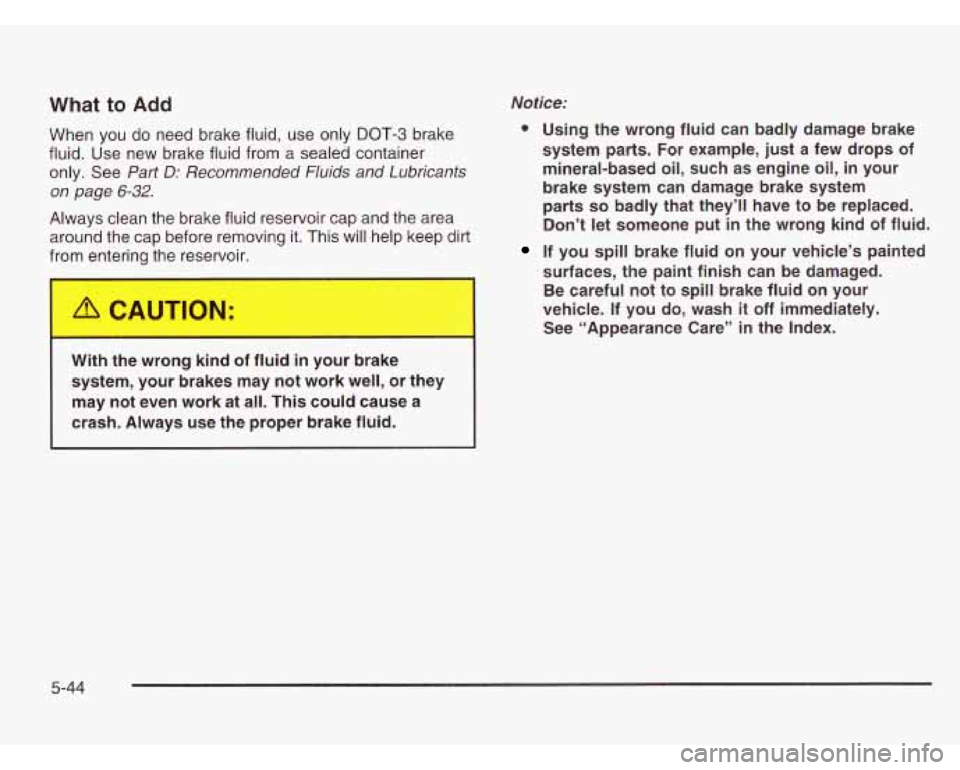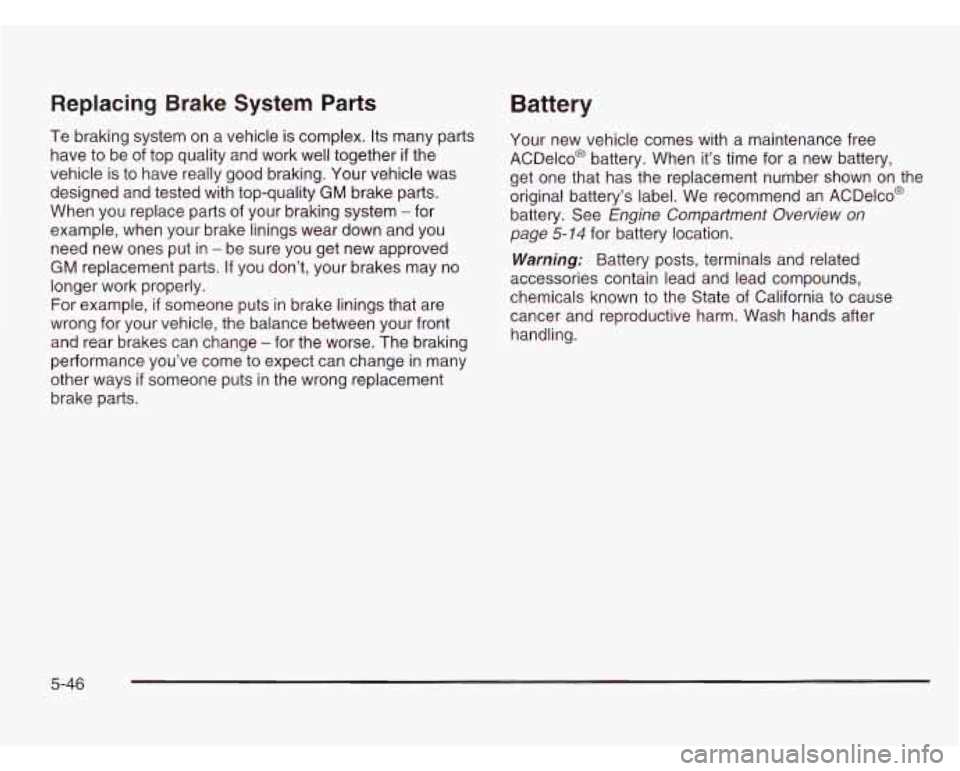Page 260 of 386
It I DU have toc ..Iuc.. >rake fluid, it can spill on
the engine. The fluid will burn if the engine is
hot enough. You or others could be burned,
and your vehicle could be damaged. Add brake
fluid only when work
is done on the brake
hydraulic system. See “Checking Brake Fluid”
in this section.
Refer to the Maintenance Schedule to determine
when to check your brake fluid. See
Part C: Periodic
Maintenance Inspections
on page 6-30.
Checking Brake Fluid
MIN / \
You can check the brake fluid without taking off the cap.
Just look at the brake fluid reservoir. The fluid level
should be above
MIN. If it isn’t, have your brake system
checked to see
if there is a leak.
After work is done on the brake hydraulic system,
make sure the level is above the
MIN but not over the
MAX mark.
5-43
Page 261 of 386

Notice:
0 Using the wrong fluid can badly damage brake
system parts. For example, just a few drops
of
mineral-based oil, such as engine oil, in your
brake system can damage brake system
parts
so badly that they’ll have to be replaced.
Don’t let someone put in the wrong kind of fluid.
If you spill brake fluid on your vehicle’s painted
surfaces, the paint finish can be damaged.
Be careful not to spill brake fluid on your
vehicle. If you do, wash
it off immediately.
See “Appearance Care”
in the Index.
What to Add
When you do need brake fluid, use only DOT-3 brake
fluid. Use new brake fluid from a sealed container
only. See
Part D: Recommended Fluids and Lubricants
on page 6-32.
Always clean the brake fluid reservoir cap and the area
around the cap before removing it. This will help keep dirt
from enterinn the reservoir.
I
With the VI .-.. =I kir.- of flui, .n your b.,.re
system, your brakes may not work well, or they
may not even work at all. This could cause a
crash. Always use the proper brake fluid.
5-44
Page 263 of 386

Replacing Brake System Parts
Te braking system on a vehicle is complex. Its many parts
have to be of top quality and work well together
if the
vehicle is to have really good braking. Your vehicle was
designed and tested with top-quality
GM brake parts.
When you replace parts of your braking system -for
example, when your brake linings wear down and you
need new ones put
in - be sure you get new approved
GM replacement parts. If you don’t, your brakes may no
longer work properly.
For example,
if someone puts in brake linings that are
wrong for your vehicle, the balance between your front
and rear brakes can change -for the worse. The braking
performance you’ve come to expect can change
in many
other ways
if someone puts in the wrong replacement
brake parts.
Battery
Your new vehicle comes with a maintenance free
ACDelco@ battery. When it’s time for a new battery,
get one that has the replacement number shown on the
original battery’s label. We recommend an ACDelco@
battery. See
Engine Compartment Overview on
page 5-74 for battery location.
Warnings Battery posts, terminals and related
accessories contain lead and lead compounds,
chemicals known to the State
of California to cause
cancer and reproductive harm. Wash hands after
handling.
5-46
Page 266 of 386

Fans or other moving engine p-. ts can injure
you badly. Keep your hands away from moving
parts once the engine
is running.
5. Check that the jumper cables don’t have loose or
missing insulation.
If they do, you could get a
shock. The vehicles could be damaged too.
Before you connect the cables, here are some
basic things you should know. Positive
(+) will go
to positive
(+) or to a remote positive (+) terminal
if the vehicle has one. Negative (-) will go to a
heavy, unpainted metal engine part, or to a
negative
(-) terminal if the vehicle has one.
Don’t connect positive
(+) to negative (-) or you’ll
get a short that would damage the battery and
maybe other parts, too. And don’t connect the
negative
(-) cable to the negative (-) terminal on
the dead battery because this can cause sparks.
6. Connect the red
positive
(+) cable to the
positive
(+) terminal
of the vehicle with the
dead battery.
Use
a remote positive (+)
terminal if the
vehicle has one.
7. Don’t let the other end
touch metal. Connect it
to the positive
(+)
terminal of the good
battery. Use a remote
positive
(+) terminal
if the vehicle has one.
5-49
Page 267 of 386
The other end of the negative (-) cable does not
go to the dead battery. It goes to a heavy,
unpainted metal engine part, or to a remote
negative
(-) terminal on the vehicle with the
dead battery.
Notice: Damage to your vehicle may result from
electrical shorting
if jumper cables are removed
incorrectly. To prevent electrical shorting, take care
that the cables don’t touch each other
or any
other metal. The repairs wouldn’t be covered by
your warranty.
5-50
Page 268 of 386
Jumper Cable Removal
A. Heavy, Unpainted Metal Engine Part
B. Good Battery
C. Dead Battery
To disconnect the jumper cables from both vehicles,
do the following:
1. Disconnect the black negative (-) cable from the
2. Disconnect the black negative (-) cable from the
3. Disconnect the red positive (+) cable from the
4. Disconnect the red positive (+) cable from the
vehicle that
had the dead battery.
vehicle with the good battery.
vehicle with the good battery.
other vehicle.
5-5 1
Page 288 of 386
Changing a Flat Tire
If a tire goes flat, avoid further tire and wheel damage
by driving slowly to a level place. Turn on your hazard
warning flashers.
Changing a tire can cause an injury. The
vehicle can slip
off the jack and roll over you
or other people. You and they could be badly
injured. Find a level place to change your tire.
To help prevent the vehicle from moving:
1. Set the parking brake firmly.
2. Put the shift lever in PARK (P).
3. Turn off the engine.
4. Put the wheel blocks at the front and rear
of the tire farthest away from the one
being changed. That would be the tire
on the other side of the vehicle, at the
opposite end. The following steps will tell
you how to
use the jack
and change a tire.
5-7 1
Page 308 of 386
Vehicle Identification
Vehicle Identification Number (VIN) Service Parts Identification
Label
You’ll find this label on the front passenger door frame.
It’s very helpful
if you ever need to order parts. On this
label is:
your VIN,
the model designation,
paint information and
a list of all production options and special equipment.
Be sure that this label is not removed from the
vehicle.
This is the legal identifier for your vehicle. It appears on
a plate in the front corner of the instrument panel, on
the driver’s side. You can see it
if you look through the
windshield from outside your vehicle. The VIN also
appears on the Vehicle Certification and Service Parts
labels and the certificates of title and registration.
Engine Identification
The 8th character in your VIN is the engine code.
This code will help you identify your engine,
specifications and replacement parts.
5-9 1